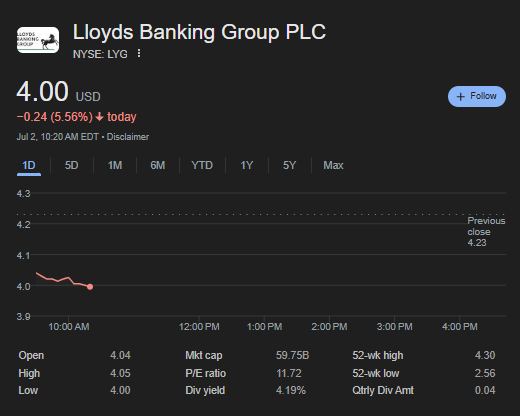Value Alert: Lloyds Banking Group (LYG) Pullback Creates Major Opportunity for Income Investors, Boosting Dividend Yield to 4.19%

NEW YORK – While broader market movements pushed shares of Lloyds Banking Group PLC (LYG) lower on Tuesday, savvy value and income-focused investors are taking notice of a compelling opportunity. The stock, trading at $4.00, saw a 5.56% decline, but this pullback has put the spotlight on the company’s incredibly strong fundamentals, particularly its robust dividend and attractive valuation.

For long-term investors, such price dips in fundamentally sound companies are often viewed not as a crisis, but as a sale. The market is currently offering shares in one of the UK’s largest financial institutions at a discount, a move that enhances what is already one of its most attractive features: a substantial dividend yield.
An Income Investor’s Dream: The 4.19% Dividend Yield
In today’s market, finding reliable income is paramount. Lloyds Banking Group stands out with an impressive dividend yield of 4.19%. The morning’s price drop makes this yield even more attractive for new buyers. A lower share price means that every dollar invested buys a larger piece of the company and a greater share of its dividend payouts. With a quarterly dividend of $0.04 per share, LYG provides a consistent and significant income stream for its shareholders.
A Deep Value Proposition with a Low P/E Ratio
Beyond the dividend, the valuation metrics for Lloyds scream “value.” The company boasts a Price-to-Earnings (P/E) ratio of just 11.72. A P/E ratio this low is often considered a hallmark of an undervalued stock, suggesting that its share price is modest relative to its profitability.
This isn’t a small, speculative company. With a massive market capitalization of $59.75 billion, Lloyds is a cornerstone of the UK banking sector. This combination of a low P/E ratio and large-cap stability is a rare find, offering a potential margin of safety for investors.
A Strong Year in Perspective
While the one-day chart shows red, the bigger picture remains positive. The stock’s 52-week range is $2.56 to $4.30. The current price of $4.00, while a pullback, is still trading near the top of its yearly range, indicating significant strength and recovery over the past year. Today’s dip could be seen as a healthy consolidation after a strong run, providing a more attractive entry point for those who have been waiting on the sidelines.
For investors who can look past the short-term noise, Lloyds Banking Group (LYG) is presenting a trifecta of opportunity: a high dividend yield, a low valuation, and the stability of a market leader.
Frequently Asked Questions (FAQ) about Lloyds Banking Group PLC (LYG)
Here are answers to more than 10 common questions about Lloyds and its stock.
1. What is Lloyds Banking Group PLC?
Lloyds Banking Group is one of the United Kingdom’s largest financial services groups. It provides a wide range of banking and financial services, including retail banking, commercial banking, and insurance, primarily in the UK.
2. What does the NYSE ticker LYG represent?
LYG represents an American Depositary Receipt (ADR) for Lloyds Banking Group. ADRs allow shares of foreign companies to be traded on U.S. stock exchanges.
3. The stock dropped 5.56% today. Is this a bad sign?
While a price drop is negative in the short term, it can create a buying opportunity for long-term investors. The lower price makes the company’s valuation more attractive and increases the effective dividend yield for new investors.
4. Does Lloyds (LYG) pay a dividend?
Yes. One of its most attractive features is its dividend. The data shows a dividend yield of 4.19% and a quarterly dividend payment of $0.04 per share.
5. What is the P/E ratio and what does it mean?
The P/E ratio is 11.72. This is a valuation metric that compares the company’s stock price to its earnings per share. A low P/E ratio, like this one, often suggests that a stock may be undervalued compared to its earnings.
6. Is Lloyds a large, stable company?
Yes. It has a market capitalization of $59.75 billion, making it one of the largest banks in Europe and a stable blue-chip company.
7. What is the 52-week price range for LYG stock?
Over the last year, the stock has traded between a low of 4.30.
8. Why would a UK bank be affected by trading in the US?
As LYG trades on the NYSE, it is subject to the same market forces and investor sentiment as U.S. stocks during the trading day, including reactions to U.S. economic data and broader market trends.
9. What are the primary risks of investing in a bank like Lloyds?
Risks include sensitivity to the UK and global economies, changes in interest rate policies by the Bank of England, and potential regulatory changes affecting the banking industry.
10. What currency is the stock price and dividend paid in for LYG?
The LYG ADR trades in U.S. Dollars (USD) on the NYSE, and dividends are also typically paid to U.S. investors in USD.
11. Is the dividend paid quarterly?
The data shows a “Qtrly Div Amt” of $0.04, but it’s important to note that many UK companies traditionally pay dividends semi-annually. Investors should verify the exact payment schedule. The listed yield reflects the annualized total.
12. Who are Lloyds’ main competitors?
Its main competitors in the UK banking market include Barclays (BCS), HSBC (HSBC), and NatWest Group (NWG).
